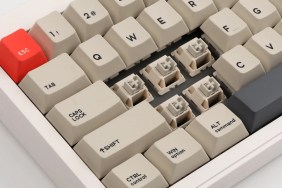Something sounds fishy.
Despite our cold, Gestapo demeanor, we don’t have very strict policies regarding which games we choose to review. Obviously, big name, triple-A titles are dealt with first, followed by those that pique our particular interests, followed by less interesting, random software, followed by weird, European games about sheep trading or something. The math is quite easy.
But regardless of the pedigree, all the titles we review share a singular bond, an undeniable quality uniting the brightest of the bright with the crappiest of the crappy: they are games.
[image1]Except this one. Electroplankton is not a game. It’s not even vaguely game-like, as it contains no challenges to master, skill sets to enhance, levels to complete, goals to accomplish, rewards to attain, or competition to destroy. That might seem odd since it comes from Nintendo, the self (and fanboy)-described purveyors of all things gaming, and yeah, we agree. Weird city. In fact, the only thing weirder about Electroplankton‘s non-gaming-ness is the fact that this stylish, innovative toy somehow screws up the one thing it sets out to do: turn your DS into a musical instrument.
The premise is so absurd, though, we have to applaud it. This un-game revolves around ten microscopic, Pokemon-ish creatures, the electroplankton, which respond to stimuli by burping out sounds. In simpler terms, you use these cute little beasts to make music by tapping them, talking to them, blowing on them and drawing on them (sort of like what you do to your guitar when no one’s looking). You can alter the tempo with the D-Pad, but most of your time is spent with the stylus.
Even seasoned musicians will have a hard time wrapping their heads around the functionality powering the planktons. The most basic is the Tracy fish, which responds to simple hand-drawn lines and spits out notes based on shape, length and drawing speed. You can draw up to six Tracys at once, creating a cacophony of twinkling scales as the fish swim down the lines.
Or dig the Luminaria, four star-shaped plankton that follow arrows. Changing the directions of the arrows changes their course, and in turn, their sounds. The bizarre Nanocarp form shapes based on hand-claps; you can then send a wave across them all to produce a harmonious series of tones. I especially dig the Hanenbow, little fish that propel themselves out of a pool of water using a floating leaf, striking the branches of a tree on their way back down. Changing the arc of the leaf or the branches alters their trajectory, creating all kinds of different rhythmic patterns and notes as they fall. Two of the remaining plankton, Rec-Rec and Volvoice, can record sounds, allowing you to belch into the mic and distort it a little.
[image2]It’s also impossible to overlook the Betnes, five thin, kite-like plankton that, when tapped along the vertebrae, produce tons of original NES tones. These come in four sets complete with pre-made back beats, so you can rock to a Mario Brothers riff using Mario’s jump. Nerd.
The different kinds of interaction and the variety of sounds emitted by the electroplankton are, in a word, awesome. There’s an impressive synth sound bank tucked in here, and the stylish, inventive way of creating the sounds makes this a unique tool. It doesn’t matter if you’re an electronica geek or a metal god – any sort of music fan will be floored by the surprising depth of tones found by simply whipping the stylus around the touch screen. It’s hard not to appreciate the effort and artistry powering the tech.
For five minutes, that is. After that, you’ll inevitably try switching from one plankton to another in order to create a song, only to find that your short, looped Tracy masterpiece has disappeared. For untold reasons, you can’t layer tracks on top of one another to write something interesting as there is no mixing allowed. You can’t use the funky Hanenbow groove you just penned as a bass line, and then stick a cool Luminaria cascade on top of it. You can’t freshen up that retro Beatnes ditty with a wicked voice sample. If you want to actually rock it live, you’ll need multiple DS’s and multiple copies of the game. Astonishingly, Electroplankton is a one-track pony.
And even the most tone-deaf Pollyanna can’t overlook the absolutely maddening lack of any save functionality. Spent some time writing a cool groove? Kiss it goodbye once you shut off your DS, because the game – sorry, program – doesn’t let you save anything. Musicians might find Electroplankton useful if they run a line out into a recording device, sample a looped groove, then use it as a track in Pro Tools, but that’s a helluva stretch.
[image3]Things only get worse when you realize what this combination of omissions means for the whole experience. The lack of multiple tracks and the inability to save effectively turns Electroplankton into a brutally limited tech-demo missing essential core features. Imagine starting up Photoshop only to discover that you can’t mix and match shapes, colors and brushes or save anything. There’s no game here, so any sort of long-term challenge is non-existent. It allows you to play with sounds but gives you no way to create any lasting songs. What, pray tell, is the point?
Presumably, the point of Electroplankton is to have fun pinching virtual fish to make sounds as some sort of artsy statement. The mind behind the madness, Toshio Iwai, is a legitimate multi-media artist with ties to greats like Hayao Miyazaki, so perhaps it’s an experiment in sound visualization. However you wish to view it, though, you’d be hard-pressed to see this as anything but an overpriced, handheld Casio. With no drums.
Electroplankton comes with only two modes – Performance and Audience. The only difference between them is that the game plays itself in Audience mode and you take over when you want to. But since nothing can be saved and you’re still just toying with one track, I don’t see why you’d bother interrupting the musical masturbation. Let your DS have its fun.
Because Zappa knows, you won’t have much of that with Electroplankton. Despite its innovation, charm and style, the glaring functionality omissions render it impotent. You turn it on, draw out some cool sounds for a couple minutes, and then shut it off wondering why you can’t save anything. It’s not a bad game – it’s not a game at all, remember – just an incomplete product. And you don’t need perfect pitch to hear my pain.
-
Super stylish
-
Totally innovative way to manipulate sound
-
Totally limited way to make music
-
No mixing?!
-
No saving?!?!
-
No game.











